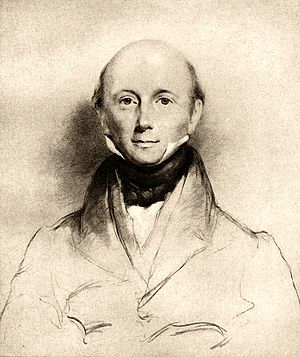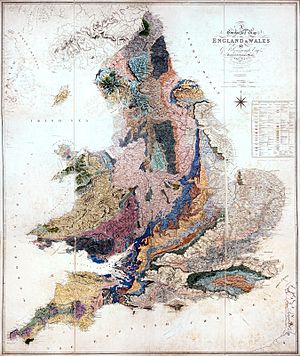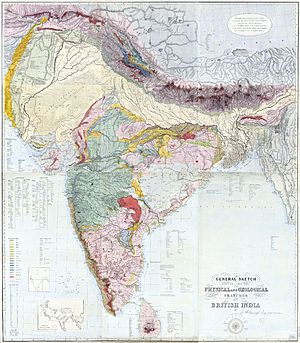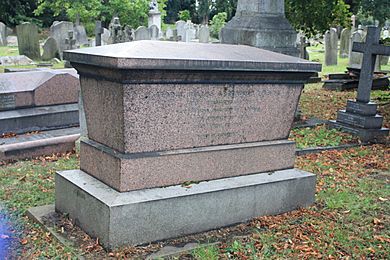George Bellas Greenough facts for kids
Quick facts for kids
George Bellas Greenough
|
|
|---|---|

Portrait by Maxim Gauci
|
|
| Born | 18 January 1778 |
| Died | 2 April 1855 (aged 77) |
| Alma mater | Pembroke Hall, Cambridge University of Göttingen |
| Scientific career | |
| Fields | Geology |
| Academic advisors | Johann Friedrich Blumenbach |
| Influences | Johann Friedrich Blumenbach, Jean-André Deluc |
George Bellas Greenough (1778–1855) was an important early English geologist. He is known for bringing together many ideas in geology, rather than just doing new research himself.
Greenough was trained as a lawyer. He was a great speaker. His speeches as the first president of the Geological Society of London helped guide geological research of his time. He also created the first geological map of England and Wales in 1820. Later, he made the first geological map of British India. Greenough described himself as having "bright eyes, silver hair," and a "fondness for generalisation." He was also "diligent, patient and zealous."
Contents
Early Life and Family
George Bellas Greenough was born in London on January 18, 1778. His birth name was George Bellas, like his father. His father was a lawyer with a good business. His mother was the daughter of a successful pharmacist.
When George was six, both his parents died. He was adopted by his grandfather, who had earned a lot of money selling medicines for coughs and toothaches.
His grandfather sent him to school at Eton for a year, then to Dr. Thompson's school in Kensington for six years. While at school, he took his grandfather's last name, Greenough.
Education and Early Travels
In 1795, Greenough went to Pembroke Hall, Cambridge to study law. He stayed for three years but did not finish his degree.
In 1798, he went to the University of Göttingen in Germany to continue his law studies. He expected the classes to be in Latin, but they were all in German! To learn the language, Greenough attended lectures on natural history by Johann Friedrich Blumenbach. These lectures sparked his interest in minerals and geology. While in Göttingen, he became good friends with the poet Samuel Taylor Coleridge.
In 1799, Greenough went on trips to the Harz mountains. He collected minerals and studied rock collections in the towns he visited.
After returning to England in 1801, his interest in geology grew. He toured England and met the famous scientist Humphry Davy. Greenough later attended Davy's lectures in London. Over the next few years, he traveled to France, Italy, Scotland, and Ireland, always noting the geology he saw.
Politics and Public Service
The year 1807 was important for Greenough. He used his political skills to help start the Geological Society.
He was elected as a Member of Parliament for the area of Gatton and served until 1812.
Greenough also served in the Light Horse Volunteers of London and Westminster. This was a group of volunteers, mostly businessmen, who paid to join and serve. They could be called upon to help keep order. Greenough joined as a private soldier in 1803. In 1808, he became an officer. He served for 11 years. In 1819, he resigned because he disagreed with how the military was used in the Peterloo Massacre. He felt it was an abuse of power. This showed Greenough was a man of strong principles.
Contributions to Geology
Greenough's interest in science grew in 1807. He joined many important scientific groups, including the Royal Society. He also joined a small group of mineralogists that soon became the Geological Society of London. Greenough was a main founder and the first president of this society. He served as president multiple times and helped geology grow as a science.
In 1819, he published a book called A Critical Examination of the First Principles of Geology. The next year, the Geological Society released his famous Geological Map of England and Wales. This map was a huge team effort. Greenough led a committee that collected information from members across England and Wales. They sent in details about local rocks, which Greenough then put together on a map.
Greenough believed in collecting facts and observations first, rather than starting with a theory. He wanted to find out where different rocks were located. He received help from many geologists, including William Buckland and Henry De la Beche.
A first version of the map was ready in 1812. However, there were problems with the printing. In 1815, William Smith published his own famous geological map. When Greenough's map finally came out five years later, it was clear he had used some of Smith's work. Greenough's map, however, had more geological details and was better drawn. Smith had used fossils to identify rock layers and map them. Greenough was not as convinced about the usefulness of fossils. This difference in approach might have slowed down his map's creation.
Some people have said that Greenough and the Geological Society did not work with William Smith because they looked down on him. However, others argue that Greenough simply did not believe fossils could tell much about rocks. He thought fossils were not very useful for figuring out the age or conditions of rocks. For this reason, Greenough wanted his map to be different from Smith's. Both maps are now displayed side-by-side at The Geological Society in London.
In 1843, Greenough began working on a geological map of British India. He never visited India himself. Instead, he gathered information from many officers in the East India Company. He compiled this information to create a large-scale geological map of British India, published in 1854. This map was a pioneering effort, even though it contained some errors because he worked remotely.
Greenough supported many scientific societies. In 1831, he helped create the British Association for the Advancement of Science. He also helped found the Geographical Society of London in 1830, which later became the Royal Geographical Society. He served as its president from 1839 to 1841. He pushed for more scientific mapping of physical features.
Greenough also held weekly open meetings for scientists at his home. This allowed people to share ideas and discoveries.
Home and Residence
In 1822, Greenough built a large house called a villa in Regent's Park in London. It was designed by Decimus Burton. This house, now known as Grove House, was his home for the rest of his life. It is located near the Regents Canal.
Death and Legacy
Greenough traveled throughout his life. At 76, he went to Italy and the East to connect his research on India's geology with Europe's. However, he became ill in Naples and died on April 2, 1855.
He is buried in Kensal Green Cemetery in North London. A marble statue of him is at the Geological Society of London.
Greenough left his fossil collection to the Geology Department at University College London (UCL). His notebooks are also kept at UCL Library. The student geological society at UCL is named after him.
The Greenough River in Western Australia was named after him in 1839. This was because Greenough supported Captain George Grey's exploration north of Perth. A small town called Greenough also grew in the area.
Selected Writings
- A Critical Examination of the First Principles of Geology (1819)
- Geological Map of England and Wales (1820)
- General Sketch of the Physical and Geological Features of British India (1854)




